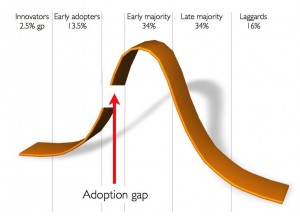 “Science fiction,” literary critic Frederic Jameson once said, “is a kind of nostalgia for the present.”
“Science fiction,” literary critic Frederic Jameson once said, “is a kind of nostalgia for the present.”
Meaning: when faced with the possibility of revolutionary change, it’s human nature to frame it in reductive metaphors. A car is a horseless carriage. A TV is radio with pictures. Steel cable is wire rope. A Blackberry is a wireless telephone. Information is “intellectual property.”
I thought of this again reading Nate Anderson’s recent post at Ars Technica, a wonderful piece he called “100 years of Big Content Fearing Technology—in its Own Words.” Anderson, Associate Editor at the site, detailed some of the most inflammatory comments made by information content producers and distributors in response to revolutionary technologies of the past—the player piano, the VCR, the photocopier.
In every case, those with a vested economic interest in existing media and business models for exploiting it see every breakthrough as catastrophic. The photocopier will put an end to books. The VCR will be the death of the movie industry. Napster will destroy the music business. “I say to you that the VCR is to the American film producer and the American public,” the late Jack Valenti fumed, “as the Boston Strangler is to the woman home alone.”
It’s fun to read these quotes in retrospect, because the irony is always that disruptive technologies invariably create new uses, new markets, and new wealth, much of it captured by those trying the hardest to make time run backward and uninvent the new media. The VCR, it’s now completely clear, saved the movie industry. Or rather, it transformed it into a new industry, bigger, more productive, and richer than the old one.
Anderson has some sympathy for the doomsayers, though, and so do I. For one thing, the transition to new media is rarely a gentle one. Consumers experimenting with new technologies often bypass existing channels, ignore borders and boundaries, and break the law. We don’t call them disruptive technologies for nothing.
In the end, as I argue in The Laws of Disruption, those who cling to a dying past always turn to law, usually a combination of lawsuits, regulatory change, and new laws forced through to put the brakes on the inevitable. Sometimes it helps to slow things down, maybe just a little. Often it warps the direction of change, creating unintended and unexpected consequences that often boomerang. The movie industry lost their case to ban the Betamax, thank goodness. Yet Sony, which won the case, lost the market to the more open and more customer-focused VHS.
The new medium, to badly paraphrase Marshall McLuhan, creates a new message. But it’s impossible to get that message until consumers have a chance to play with the medium for a while. How long depends in part on how quickly the technology reaches critical mass. Thanks to Moore’s Law, that period has gone from years to months.
There’s almost not enough time to resist. So why bother?
I am regularly drawn to this quote from the pioneering antitrust lawyer Brooks Adams, great grandson of John Adams. Arguing before the Interstate Commerce Commission a little over a hundred years ago, Adams wrote:
There is no ancient and abstract principle of right and wrong which can safely be deduced as a guide to regulate the relations of railways and monopolies among our people, because railways and monopolies are products of forces unknown in former times. The character of competition has changed, and the law must change to meet it, or collapse. Such is my general theory.
Adams was cadging the Commissioners. The law always collapses, as he well knew. Which is not as bad as it sounds. Soon enough, old metaphors are replaced by new metaphors, and with them a new legal system that better fits the new reality.
That, after all, is what a revolution is: replacing one system of government with a different, perhaps better, system.

